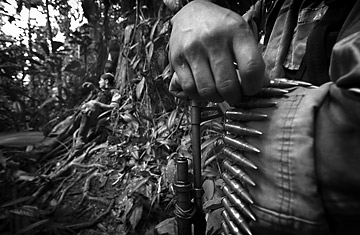
Members of a FARC unit patrol a jungle near the Pacific coast of Colombia.
(2 of 3)
Stansell, Howes and Gonsalves were monitoring the jungle as part of a U.S. aid project called Plan Colombia. Begun in 2000, the plan has cost more than $5 billion, making Colombia the fourth largest recipient of U.S. aid, after Iraq, Israel and Egypt. The plan is designed to combat both cocaine production and groups like the FARC that profit from the trade. Although Colombia has failed to stem cocaine production, the cash has at the very least helped rebuild Colombia's military, which in turn has knocked the FARC back on its heels. The rebels have seen their ranks of almost 20,000 fighters halved in the past five years, according to U.S. military intelligence, while their morale, territorial control and command structure are waning. "Each day the FARC is a less viable force," says Colombian Vice President Francisco Santos. "They have scant popular support." Indeed, while Uribe enjoys an 84% approval rating, tens of thousands of Colombians have staged marches this year condemning the guerrillas.
In that climate, there has been guarded hope that the FARC wants to discuss the release of the Americans and its more than 700 Colombian military, police and civilian hostages. U.S. Representative Jim McGovern of Massachusetts, who is involved with the campaign to free the Americans, says, "The FARC seems engaged on this issue for the first time ever." Since the start of the year, the group has handed six hostages — including a Colombian congresswoman and a former vice-presidential candidate — over to Chavez. But Colombia now accuses Chavez of supporting the FARC financially. (He denies it.)
Amidst those muddled Andean politics, some suggest a better hope for the Americans may be sitting inside U.S. jails. In 2004 and 2005, Colombia extradited to the U.S. two FARC leaders, Ricardo Palmera, a.k.a. Simon Trinidad, and Omaira Rojas, a.k.a. Sonia. Sonia was convicted last year on drug charges and given 17 years in prison; Trinidad, convicted for conspiracy in the Americans' capture, was sentenced to 60 years in January. The FARC has made the pair's release a condition for the U.S. hostages' freedom. The U.S. has designated the FARC a terrorist group and can't negotiate with it. But U.S. sources say they're hearing signals the FARC might accept significantly reduced sentences for Sonia and Trinidad, which the two could win during their appeals. Says Alfredo Rangel, director of the Security and Democracy Foundation in Bogota: "If a U.S. appellate judge cuts Trinidad's sentence to, say, below 20 years, it puts the ball in the FARC's court." Another possibility: the pair's transfer to, and lighter sentences in, prisons in France as part of the possible Betancourt exchange. "We aren't discounting [either] scenario," says a U.S. official familiar with the case.
U.S. sources stress they have as yet heard nothing concrete from the FARC. Meanwhile, the American hostages follow a dismal routine, say Pinchao and other recently released hostages. They are forced into days-long marches to new camps when the FARC fears the military is close. Their rice-and-bean meals are varied only when they're near a river or an area where wild pigs roam, and they often fight illnesses like hepatitis with only poorly trained nurses to treat them. (The FARC refuses visits by Red Cross medical teams.) Pinchao, 37, says Stansell taught him how to swim during river-bathing sessions — a skill that later helped him escape. Stansell also tries to keep the hostages' spirits up. "Keith even learned how to tell jokes in Spanish," he recalls. Like Stansell, Gonsalves and Howes have children in the U.S. Howes, from Massachusetts, has eased his depression by adopting a stray dog. Gonsalves, of Connecticut, spends his days lifting makeshift weights and reading a Spanish Bible. The men cannot receive letters but do hear news of their families broadcast on Colombian radio.
>